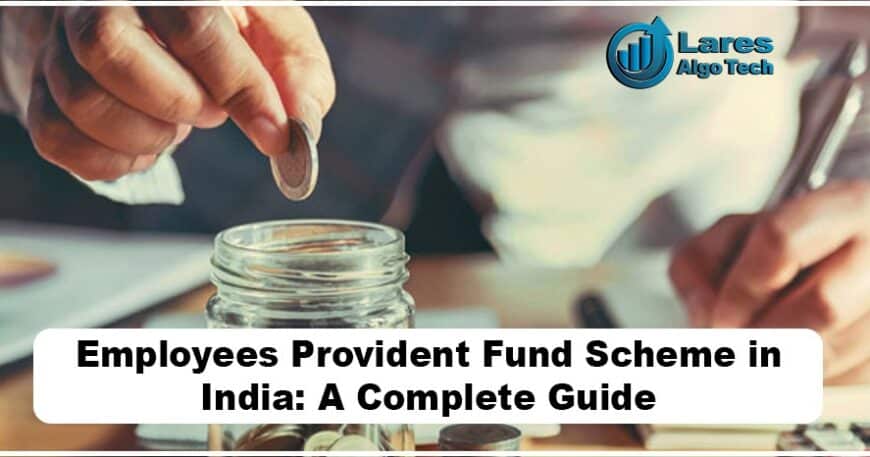Are you looking for a way to save money for your retirement and enjoy tax benefits at the same time? If yes, then you should know about the Employees Provident Fund Scheme in India. EPF is a government-backed savings scheme that helps employees build a corpus for their post-retirement life. In this blog, we will explain everything you need to know about EPF, such as its features, benefits, rules, contribution, withdrawal, and more. Read on to find out how EPF can help you secure your financial future.
What is EPF?
EPF stands for Employees Provident Fund, which is a retirement savings scheme established by the Indian government in 1952. It provides financial security to employees when they retire from their jobs. The EPF works by allowing employers and employees to contribute money towards an individual employee’s provident fund account each month. The employer matches this amount with an equal contribution. When you retire, you receive the total amount (personal as well as the employer’s contribution) as a lump sum along with interest. The EPF is regarded as a low-risk investment as the Government of India manages it and assures a fixed rate of return. The EPF is administered by the Employees’ Provident Fund Organisation (EPFO), which is a statutory body under the Ministry of Labour and Employment.
Who is eligible for the Employees Provident Fund Scheme in India?
EPF is mandatory for all employees who work in an establishment that has 20 or more employees. The provision of an EPF account is compulsory for employees with a salary of less than ₹15000. However, most companies provide the facility to all employees regardless of their salary. Some companies with fewer than 20 employees also adopt the EPF scheme voluntarily. EPF is also applicable to international workers who are employed in India or who are working in a country that has a social security agreement with India.
How much do you contribute to EPF?
As an employee, you have to contribute 12% of your basic salary plus dearness allowance (DA) and retaining allowance (RA) towards your EPF account every month. The employer also contributes an equal amount of 12%, but not all of it goes to your EPF account. Out of the employer’s contribution, 8.33% goes to the Employees’ Pension Scheme (EPS), which provides you with a monthly pension after retirement, and the remaining 3.67% goes to your EPF account. The current rate of interest on EPF deposits is 8.15% per annum.
However, there are some exceptions to the 12% contribution rate. For example, if a company meets the following criteria, it can contribute only 10% instead of 12%:
- Has less than 20 employees
- Suffers losses that are more than its entire net worth
- Belongs to the jute, beedi, brick, coir, or guar gum industry
Another exception is for women employees. As per the 2018-19 Union Budget, new women employees can contribute only 8% (instead of 12%) towards their EPF account for the first three years of employment. This is done to encourage companies to hire more women and to give women a higher take-home pay. However, the employer’s contribution remains 12% for women employees as well.
How to open an EPF account?
To open an EPF account, you need to fill up a declaration form (Form 11) and submit it to your employer along with your KYC documents, such as PAN, Aadhaar, bank account details, etc. Your employer will then register you with the EPFO and allot you a Universal Account Number (UAN). UAN is a 12-digit unique number that identifies you as an EPF member across different employers and establishments. You can use your UAN to access your EPF account online, check your balance, transfer your funds, withdraw your money, and update your details. You can also link your UAN with your UID, mobile number, and bank account for easy verification and transactions.
How to check your EPF balance?
You can check your EPF balance online by logging in to the EPFO portal () using your UAN and password. You can also download your EPF passbook, which shows your monthly contributions and interest earned. Alternatively, you can check your EPF balance by using the UMANG app (), which is a unified platform for various government services. You can also check your EPF balance by sending an SMS to 7738299899 from your registered mobile number with the format EPFOHO UAN <LAN>, where <LAN> is the first three letters of your preferred language. For example, EPFOHO UAN ENG for English. You can also check your EPF balance by giving a missed call to 011-22901406 from your registered mobile number.
How to withdraw your EPF money?
You can withdraw your EPF money either partially or fully, depending on your situation. You can make a partial withdrawal for specific purposes, such as marriage, education, medical treatment, home loan repayment, house purchase or construction, etc., subject to certain conditions and limits. You can make a full withdrawal when you retire, resign, or get terminated from your job. However, if you remain unemployed for more than two months, you have to transfer your EPF account to the National Pension System (NPS) or withdraw your money within one month.
To withdraw your EPF money, you need to fill up a withdrawal form (Form 19 for EPF and Form 10C for EPS) and submit it to your employer or directly to the EPFO. You can also apply for withdrawal online by logging in to the EPFO portal or the UMANG app and selecting the claim option. You need to have your UAN, Aadhaar, and bank account linked and verified for online withdrawal. The withdrawal process usually takes 15 to 20 days, and the amount is credited to your bank account.
Tax implications of the Employees Provident Fund Scheme in India
The contributions made by you and your employer towards your EPF account are eligible for tax deduction under Section 80C of the Income Tax Act, up to a limit of ₹1.5 lakh per year. The interest earned on your EPF account is also exempt from tax, as long as it does not exceed 9.5% per annum. The withdrawal of your EPF money is also tax-free, provided you have completed five years of continuous service. However, if you withdraw your EPF money before completing five years of service, you have to pay tax on the following components:
- The employer’s contribution and the interest earned on it
- The interest earned on your contribution
The tax rate depends on your income tax slab and the surcharge and cess applicable. You also have to pay a 10% TDS (tax deducted at source) on the withdrawal amount if it exceeds ₹50000 and if you have not submitted your PAN. You can avoid tax on premature withdrawal by transferring your EPF account to your new employer or the NPS.
Conclusion
Employees Provident Fund Scheme in India is a great way to save money for your retirement and enjoy tax benefits along the way. It is a safe and secure investment that offers a guaranteed return and a monthly pension. However, you should not withdraw your EPF money before retirement, unless it is necessary, as it will reduce your retirement corpus and attract tax. You should also keep track of your EPF account regularly and update your details whenever there is a change. By doing so, you can ensure that your EPF money grows and serves you well in your golden years.





